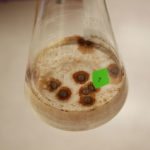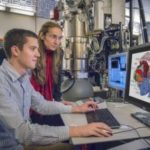 The Advanced Biofuels Process Demonstration Unit (ABPDU) is featured in the new Cyclotron Road video. Cyclotron Road located at Berkeley Lab is a home for top entrepreneurial researchers to advance technologies until they can succeed beyond the research lab. The Visolis project led by Deepak Dugar which aims at the bio-based production of carbon-negative, high-performance polymers, proved its process at ABPDU’s 300 liter scale fermenters. Watch the video here.
The Advanced Biofuels Process Demonstration Unit (ABPDU) is featured in the new Cyclotron Road video. Cyclotron Road located at Berkeley Lab is a home for top entrepreneurial researchers to advance technologies until they can succeed beyond the research lab. The Visolis project led by Deepak Dugar which aims at the bio-based production of carbon-negative, high-performance polymers, proved its process at ABPDU’s 300 liter scale fermenters. Watch the video here.
DOE JGI User Facility Partnership Yields Comparative Fungal Analysis
“[H]aving access to the capabilities at the DOE JGI and EMSL ‘proved to be a powerful tool in exploring the molecular mechanisms of carbon degradation by soil microbes.’”
In a Plos ONE study, a team led by researchers at Harvard University and Woods Hole Oceanographic Institution (WHOI) conducted a comparative analysis of the secretomes of four recently-isolated and sequenced filamentous Ascomycete fungi to learn more about the variety of pathways they deploy to break down carbon compounds. The team’s study was made possible by a partnership between the two national user facilities called Facilities Integrating Collaborations for User Science or FICUS. The partnership allows scientists around the world to draw on capabilities at both SC user facilities to get a more complete understanding of fundamental scientific questions. Read more on the DOE JGI website.
JBEI’s Ee-Been Goh Featured on Laboratory Equipment
JBEI Research Scientist, Ee-Been Goh was featured in an article by Laboratory Equipment to talk about what she is working on, whom she is mentoring and her take on what it’s like to be a female in the male-dominated science space. Read more
Ignacio Tinoco’s 59 Years in Chemistry Profiled
Ignacio Tinoco, Jr., an affiliate in the Molecular Biophysics & Integrated Bioimaging Divsion, has been a pioneer in many fields, but he is most known for his invaluable contribution to the study of RNA folding. He has taught in UC Berkeley’s chemistry department for 59 years. When he first started on the faculty, he was advised by the dean to wear a tie so that he could be distinguished from the students. Read more in the Berkeley Science Review.
New Technologies Fuel Cryo-EM’s Renaissance
In a pair of breakthrough Nature papers published recently, researchers in Eva Nogales’ Lab at UC Berkeley and Berkeley Lab (Molecular Biophysics & Integrated Bioimaging Division) mapped two important protein functions in unprecedented detail: the role of TFIID, effectively improving our understanding of how our molecular machinery identifies the right DNA to copy; and how proteins unzip double-stranded DNA, which gives us insights into the first-key steps in gene activation.
These papers are representative of the renaissance currently under way in the cryo-electron microscopy (cryo-EM) field—driven primarily by the rise of cutting-edge electron detector cameras, sophisticated image processing software and access to NERSC supercomputing resources. Read the full story, written by Linda Vu of NERSC.
- « Previous Page
- 1
- …
- 180
- 181
- 182
- 183
- 184
- …
- 213
- Next Page »
Was this page useful?







